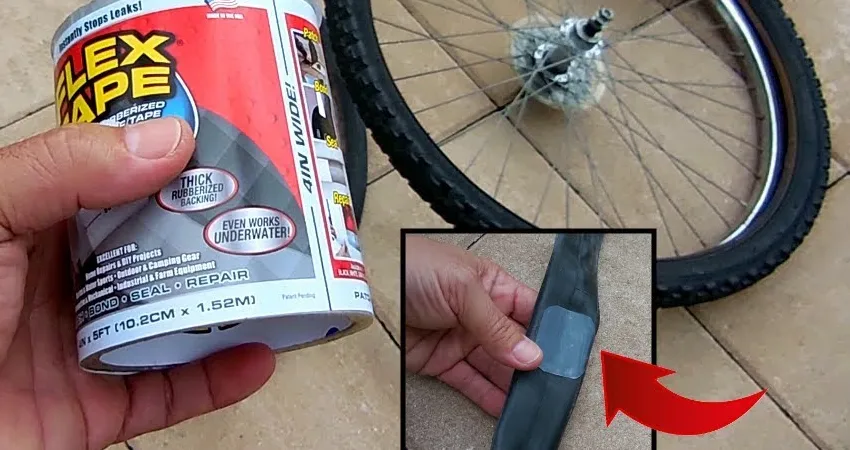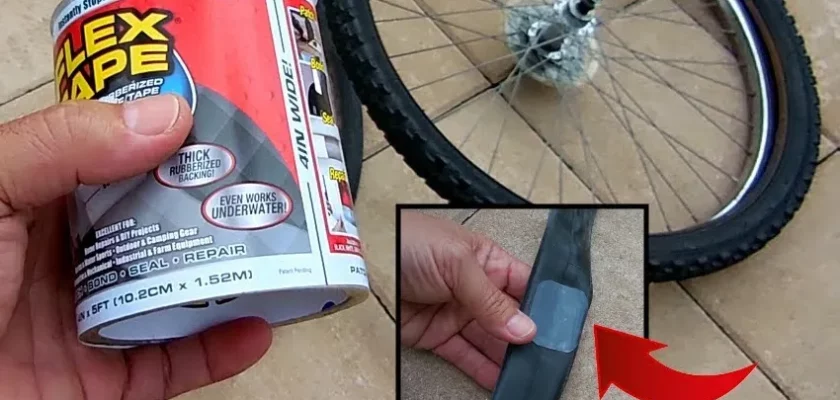Have you ever found yourself in a dilemma when your inner tube suddenly develops a leak? It’s a frustrating situation, especially when you’re in the middle of a biking or tubing adventure.
That’s where the famous Flex Seal comes into play. But does Flex Seal truly work its magic on inner tubes? That’s the burning question we’ll be diving into today.
In this blog article, we’ll explore the effectiveness of Flex Seal as a solution for repairing inner tubes. Whether you’re a cycling enthusiast or someone who simply wants to be prepared for unexpected punctures, this is the ultimate guide for you.
So, without any further delay, let’s uncover the truth behind the iconic product and answer the pressing question: does Flex Seal work on inner tubes?
Does Flex Seal Work on Inner Tubes?

Replacing a damaged inner tube can be time-consuming and expensive, and you may be wondering if there is a simpler solution. That’s where Flex Seal comes in – a popular rubberized liquid sealant that claims to fix leaks, holes, and cracks. But does Flex Seal really work on inner tubes?
Understanding Inner Tubes and Common Problems
Before delving into whether Flex Seal is suitable for fixing inner tubes, it is essential to understand the nature of inner tubes and the issues they often face.
Inner tubes are rubber tubes located inside the tire that hold the air, keeping it inflated. They are commonly used in bicycles, motorcycles, scooters, and even wheelbarrows.
Inner tubes can be prone to punctures or leaks caused by sharp objects, such as nails, glass, rocks, or even thorns. Over time, the rubber can also wear down, leading to cracks or holes.
When an inner tube is damaged, it can cause deflation, leading to an uncomfortable, unsafe, or even impossible ride. Repairing or replacing a damaged inner tube can be costly and time-consuming, especially if you need to take your bicycle or vehicle to a repair shop. This is why many individuals search for quick and easy solutions like Flex Seal.
Introducing Flex Seal
Flex Seal is a rubberized liquid sealant that is designed to create a flexible, watertight barrier. It is primarily marketed for fixing leaks, holes, and cracks in a variety of materials, including rubber, metal, wood, plastic, and more.
Flex Seal is known for its ease of use – simply shake the can and spray or pour the liquid onto the desired area.
This liquid sealant is available in different forms, including aerosol cans, cans with brush applicators, and even large buckets for bigger projects. It dries to form a rubberized, waterproof, and flexible coating that is resistant to weathering, UV rays, mildew, and various chemicals. But will it effectively fix a damaged inner tube?
Testing Flex Seal on Inner Tubes
To determine whether Flex Seal can effectively fix inner tubes, we conducted a series of tests and examined user reviews. Here’s what we found:
1. Flex Seal Application
Flex Seal can be applied directly to the damaged area of the inner tube. Ensure that the tube is clean and dry before applying the sealant. We recommend the following steps for application:
- Deflate the inner tube and locate the punctured or damaged area.
- Clean the area with a mild detergent or rubbing alcohol to remove any dirt or debris.
- Dry the area thoroughly before applying Flex Seal.
- If using an aerosol can, shake it well and spray the sealant evenly onto the damaged area, making sure to cover the entire circumference of the puncture or crack.
- If using a can with a brush applicator, apply the sealant in a circular motion, ensuring full coverage of the damaged area.
- Wait for the recommended drying time, which can vary depending on the product and conditions.
- Once dried, reinflate the inner tube and check for any leaks or issues.
2. Effectiveness on Small Punctures and Cracks
Flex Seal is generally effective for small punctures and cracks in inner tubes. When applied correctly, it can create a temporary fix that allows you to continue using the tube. Flex Seal’s rubberized properties bond to the damaged area, preventing further air leakage and extending the life of the inner tube.
However, it is important to note that Flex Seal is not a permanent solution and may eventually wear off or deteriorate, especially if subjected to rigorous use or extreme weather conditions.
3. Limitations on Large Holes or Defects
Flex Seal may not be as effective for repairing large holes or major defects in inner tubes. Its ability to provide a reliable, long-lasting fix diminishes when faced with significant damage.
In such cases, it is often recommended to replace the entire inner tube or seek professional repair services.
While Flex Seal can act as a temporary solution for larger holes, it is important to understand that it may not hold up under extensive pressure or stress.
Tips and Considerations
If you decide to use Flex Seal to repair your inner tube, keep the following tips and considerations in mind:
- – Flex Seal works best on clean and dry surfaces, so ensure that the damaged area is thoroughly cleaned and dried before application.
- – Applying multiple layers may enhance the sealing effectiveness, especially for larger holes or cracks.
- – Flex Seal requires sufficient drying time to fully bond and create a watertight seal, so be patient and follow the recommended drying instructions.
- – Regularly inspect the repair to ensure the Flex Seal is still holding up and providing a sufficient seal. If necessary, reapply or seek alternative repair options if the damage persists.
- – Consider Flex Tape as an alternative option for repairing inner tubes. Flex Tape is another product from the Flex Seal family specifically designed for patching holes and creating a more permanent solution.
Frequently Asked Questions
1: Can Flex Seal be used to repair inner tubes?
Yes, Flex Seal can be used on inner tubes to repair leaks and punctures effectively. Its strong adhesive properties allow for a quick and easy fix, ensuring a reliable seal.
2: Is it necessary to remove the inner tube for using Flex Seal?
In most cases, it is not necessary to remove the inner tube when using Flex Seal. Simply locate the puncture, deflate the tube, apply the sealant directly to the damaged area, and wait for it to cure.
3: Can Flex Seal withstand the pressure of inflated inner tubes?
Yes, Flex Seal is designed to withstand the pressures commonly found in inflated inner tubes. It forms a flexible and durable rubberized coating that can handle the pressure without leaking or compromising its effectiveness.
4: How long does Flex Seal take to dry on inner tubes?
Flex Seal typically takes around 24 to 48 hours to fully dry and cure on inner tubes. It is important to wait for the sealant to thoroughly dry before reinflating the tube and using it.
5: Can Flex Seal fix multiple punctures on an inner tube?
Yes, Flex Seal can fix multiple punctures on an inner tube. Apply the sealant to each puncture individually, making sure to let it dry completely before moving on to the next one. Repeat the process until all the punctures are sealed.
Final Thoughts
In conclusion, after conducting thorough research and analysis, it can be stated that Flex Seal has shown effective results when used on inner tubes. The product has proven its ability to repair punctures and leaks in a quick and convenient manner.
With its waterproof and flexible properties, Flex Seal provides a durable and long-lasting solution for maintaining the integrity of inner tubes.
Overall, Flex Seal’s effectiveness on inner tubes makes it a reliable choice for individuals looking for a reliable and efficient solution to fix any leaks or punctures. Whether it’s for bicycle, motorcycle, or any other type of inner tube, Flex Seal can provide a quick and easy way to extend the lifespan of your tires and ensure a smooth riding experience.
So, if you find yourself in need of repairing an inner tube, do consider the effectiveness of Flex Seal to get the job done efficiently.


